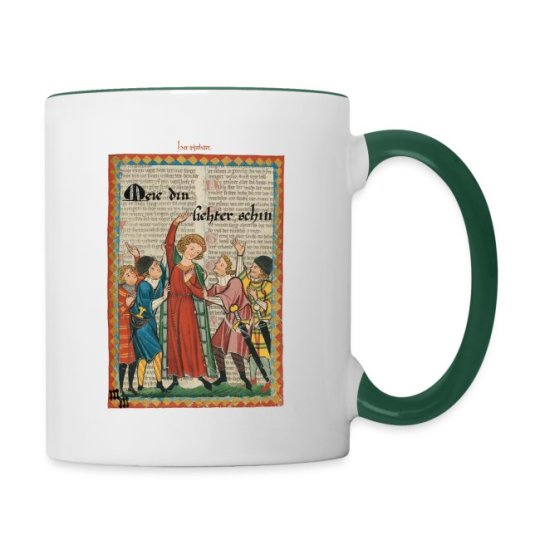#neidhart von reuental
Text


Check out our new Medieval Design! Following up on Her Walther von der Vogelweide, we are continuing our Codex Manesse line with Her Neidhart von Reuenthal, another famous Minnesänger, and contemporary of Walther. The design features hand drawn calligraphy, spelling out the first line of one of Neidhart's famous songs: Meie din liehter schin!
Check it out here!
Medieval Margins is a Norway based design project by medieval-excited HEMAists, combining art from real medieval manuscripts with hand-drawn calligraphy
#medieval#medievalcore#medieval manuscripts#codex manesse#neidhart von reuental#knightcore#bardcore#literally this is bardcore he is a bard
9 notes
·
View notes
Text


Neidhart von Reuental grave in Vienna :)
3 notes
·
View notes
Text

Neidhart von Reuental (Her Nîthart)
one of the most famous lyricists and Minnesänger of the high middle ages
Codex Manesse, c. 1300
#medieval#Minnesang#Neidhart#Neidhart von Reuental#Minne#illustration#middle ages#high middle ages#art#manuscript#codex manesse#Minnesänger
12 notes
·
View notes
Text
youtube
Neidhart von Reuental - Owê dirre nôt!
Musical Ensemble: Newberry Consort
Conductor: Mary Springfels
Counter Tenor: Drew Minter
4 notes
·
View notes
Text
youtube
A lively song from the renowned medieval German poet, Neidhart von Reuental (ca. 1190- ca. 1237). Von Reuental belonged to the era of the Minnesaenger, singers singing about Minne, or love. Meie din liechte schin means May Your Light Shine.
#neidhart von reuental#minnesang#german#deutsch#musikgeschichte#mittelalter#medieval#medieval music#germany#poetry#mittelhochdeutsch#song#love song#romance#middle ages#Youtube
0 notes
Note
i have an agenda anyway so, for the ship bingo: lietpru
That's a choice asking me, but I respect the determination!
Ship Bingo

Honest to God, first association was that time in february when the medieval crusades into Eastern Europe where implicitly mentioned in a poem by Neidhart von Reuental in my Medieval Music Middle Ages Reception class. I regrettably know very little about Eastern European history and I also regrettably ship mostly on the grounds of historical relations or cultural compatibility. Which nearly any ship can produce if you dig deep enough, but as I said - Haven't done any digging here.
I also don't ship Gilbert seriously with a lot of people? I think he is at his funniest when he is socially inept as shit and let's crushes fester, but never has the balls to say anything. And I do love our Lithuanian, but beyond "Toris is good boy, holder of the braincell, best man", I have very little thoughts on him.
So yeah! I think that ship has the potential for some absolute disaster. I love me a good hate-love, these two could get on each other's nerves so good, it'd be hilarious. I am sure that this ship could also be much more, certainly intense and dramatic and intriguing ... but to me, who lacks info beyond their Hetalia interactions and extremely limited historical knowledge, it is mostly funny and high-energy. That's why I circled the divorce field.
#beareplies#yandereleorio#aph#hws#hetalia#aph prussia#hws prussia#aph lithuania#hws lithuania#lietpru
9 notes
·
View notes
Text
Wien Reise


Wien ⋆ Donau Österreich Kultur Reise ⋆ Mythos einer Kaiserstadt
Wien Reise ⋆ Donau Österreich Kultur ⋆ Mythos einer Kaiserstadt
Wien ist immer eine Reise wert!
Wohl über kaum eine andere Stadt gibt es so viele vorgefertigte Bilder wie über Wien: die Stadt der Operette, des Walzers und des Fiakers, eines Schubert und Beethoven oder das Wien, wo auch die »Gute Alte Zeit« noch immer ihren Platz hat.
Diese Stadt aber so zu beschreiben, wie sie tatsächlich ist, ohne sie der Wirklichkeit zu entrücken, ist wohl ein schwieriges Unterfangen.
Wien ist stolz darauf, auf eine große Vergangenheit zurückblicken zu können. Nicht zuletzt bedingt durch eine überaus günstige geographische Lage, spielte Wien durch nahezu zwei Jahrtausende eine bedeutsame historische Rolle: Wien, im Herzen Europas gelegen, liegt zwischen den Alpen und den Karpaten, wo sich im sogenannten Wiener Becken uralte Verkehrs- und Handelswege kreuzen.
Wiens Seele lässt immer wieder neue Aspekte zu. Die Stadt wurde geprägt durch die Ausstrahlung verschiedenster Kulturen. Besucher sind immer wieder überrascht, wie hier das Widersprüchlichste zur Harmonie bewegt werden kann. Wolfgang Amadeus Mozart bezeichnete Wien als den herrlichsten Ort für sich und sein Metier. Die Stadt sei der beste Ort der Welt, erzählte er jedem, den er kannte.
Kaum anderswo ist das Studium der Architektur leichter als in dieser Donaustadt, wo sämtliche Stilarten und Stilepochen vorhanden sind. Berühmt sind die Wiener Malerschule, die seit dem 14. Jahrhundert besteht, und die Wiener Literatur, die ihren Ursprung auf »Fahrende und Scholaren« wie auf Neidhart von Reuental zurückführt.
Besonders erwähnt sei aber auch der Minnesänger Walther von der Vogelweide (1170-1230), der bereits am Hof der Babenberger ein beredtes Zeugnis für die damalige Pflege der Musik und Dichtkunst in Wien ablegte.
Kult sind die Wiener Kaffeehäuser, sie bilden gleichsam eine Insel der Seligen. Diese sind keine gewöhnlichen Lokale, in denen man nur Kaffee trinkt, nein, sie wollen sich vielmehr als Institution verstanden wissen, die zur Stadt gehören wie das Riesenrad oder der Stephansdom. Wien ist sicherlich immer eine Reise wert.
Read the full article
0 notes
Text
Got tagged by @the-defiant-pupil
The Rule: List 10 songs you’ve been digging lately!
1. Douce Dame Jolie - as done by Annwn
2. Tempus est Iocundum - as done by Artefactum
3. Quen Quer Que Na Virgen Fia - as done by Artefactum
4. Helvegen - Wardruna
5. Meie Din Liechter Schin - Neidhart von Reuental, as done by Michael Posch & Unicorn
6. Varulven - as done by Garmarna
7. Krummi - Valravn
8. Tri Martolod - Nolwenn Leroy
9. Nu Alrest Lebe Ich Mir Werde - Walther von der Vogelweide, as done by Michael Posch & Unicorn
10. Glundroði (feat. Sigurboði Grétarsson) - Danheim
I feel like I could add more, there are so many good songs out there I’ve been finding, mostly Medieval tho, lol. I think the newest one in this list is Tri Martolod, which is from around the 17th century? Aside from Glundroði and Helvegen, which are just done in an old style using Old Norse, but are pretty recently released.
Got Medieval French, Latin, Norse, Swedish, Icelandic, Breton, and Middle High German.
#tagged#I'm not tagging anyone#because I'm dead#falling asleep#just wanted to do this before I forgot#douce dame jolie#tempus est iocundum#carmina burana#quen quer que na virgen fia#artefactum#annwn#helvegen#vikings#wardruna#meie din liechter schin#neidhart#neidhart von reuental#michael posch#unicorn#varulven#garmarna#krummi#valravn#tri martolod#nolwenn leroy#nu alrest lebe ich mire werde#walther von der vogelweide#glundroði#danheim#Sigurboði Grétarsson
1 note
·
View note
Text
Lieben wân, den ich hân, | Sweet hope I nourish,
gein der lieben wolgetân, | for the finest love
der ist immer unverlân | I will never give it up
unde enkan noch niht vervân. | even if it shall ever be in vain.
sol diu guote mich vergân - | If my dear should reject me -
sanfter waere ich tôt. | much rather i would die.
No sweeter language for melodramatic heartache.
#history#not exactly a good translation#but you get the point#oh#and that's neidhart von reuental btw#1180-1240
3 notes
·
View notes
Text
I
Ich ruhe nimmer,
bis ich sie bekomme.
Eine, die heisst Diemel,
ganz und gar vertrau ich ihr.
Es kann ihr nicht missfallen,
worum ich immer sie bat.
Sie soll sich nicht übereilen,
Mein Feld grenzt an ihre Weide.
Ekeman, der rauft Ekemannen.
So halt sie ihren roten Mund im Zaum.
II
Ich habe an sie gewendet
gar allen meinen Sinn.
Ich meinte, ich wäre schon am Ziele.
Sie sprach: „Wo ist der Besitz?“
„Mehr kann ich euch nicht zeigen
von meinem Gut
als Reuental, mein Eigen.
Meine Mutter bracht es ein.
Herrin, das will ich euch giben-geben.“
„Herr, hibet-habet’s für euch selbst.“
III
Der ich mich aus freien Stücken
stets zu Diensten bot,
an der hab ich gesehen,
einen Gürtel rot.
Was ich ihr auch winke,
auf mich hat sie nur Zorn.
Gläsern ist die Schnalle,
von Kupfer ist der Dorn.
Ich sah’s, es war ein schmaler Riemen.
Ein Ritter hatte ihn ihr mitgebracht aus Wien.
IV
Ich kam ihr nachgeschlichen
an einen Waldessaum.
Ihr Vergnügen, das war gross
mit einem stattlichen Ritter.
Ich kam hernach dazu.
Erfreut war ich gerade nicht.
Es dauerte nicht lange
und nieder drückt’ er sie.
Rasch gab er ihr in ihre weissen Händel
etwas, das nennt man den Gimpel-Gempel.
V
Als sie den Gimpel-Gempel
in die Hand genommen,
setzt’ sie ihn an das Bäuchlein,
er drückt' ihn durch das Kräuselhaar.
„Nun beweg schnell deinen Hoppo-Popo,
damit der Gimpel-Gempel nicht zur Ruhe kommt.
Ohja-uhja, wer geht denn da?“
- Neidhart von Reuental
0 notes
Text
Minnesang was a tradition of lyric- and songwriting in Germany...

Minnesang was a tradition of lyric- and songwriting in Germany that flourished in the Middle High German period, which began in the 12th century and continued into the 14th. People who wrote and performed Minnesang were known as Minnesänger, a song was called a Minnelied. The name derives from minne, the Middle High German word for love, as it was Minnesang’s main subject. The Minnesänger were similar to the Provençal troubadours and northern French trouvères in that they wrote love poetry in the tradition of courtly love in the High Middle Ages.
In the absence of reliable biographical information, there has been debate about the social status of the Minnesänger. Some clearly belonged to the higher nobility – the 14th century Codex Manesse includes songs by dukes, counts, kings, and the Emperor Henry VI. Some Minnesänger, as indicated by the title Meister (master), were clearly educated commoners, such as Meister Konrad von Würzburg. It is thought that many were ministeriales - members of a class of lower nobility, vassals of the great lords. Broadly speaking, the Minnesänger were writing and performing for their own social class at court, and should be thought of as courtiers rather than hired musicians. Friedrich von Hausen, for example, was part of the entourage of Friedrich Barbarossa, and died on crusade. As a reward for his service, Walther von der Vogelweide was given a fief by the Emperor Frederick II. Several of the best known Minnesänger are also noted for their epic poetry, among them Heinrich von Veldeke, Wolfram von Eschenbach, and Hartmann von Aue.
The earliest texts date from around 1150; the earliest named Minnesänger are Der von Kürenberg and Dietmar von Aist, clearly writing in a native German tradition in the 3rd quarter of the 12th century. This is referred to as the Danubian tradition. From around 1170, German lyric poets came under the influence of the Provençal troubadours and the French trouvères. This is most obvious in the adoption of the strophic form of the canzone, at its most basic a 7-line strophe with the rhyme scheme ab|ab|cxc, and a musical AAB structure, but capable of many variations. A number of songs from this period match trouvère originals exactly in form, indicating that the German text could have been sung to an originally French tune, which is especially likely where there are significant commonalities of content. Such songs are termed contrafacta. For example, Friedrich von Hausen’s “Ich denke underwilen” is regarded as a contrafactum of Guiot de Provins’s “Ma joie premeraine”.
By 1190, the German poets began to again break free of Franco-Provençal influence. This period is regarded as the period of Classical Minnesang with Albrecht von Johansdorf, Heinrich von Morungen, Reinmar von Hagenau developing new themes and forms, reaching its culmination in Walther von der Vogelweide, regarded both in the Middle Ages and in the present day as the greatest of the Minnesänger. The later Minnesang, from around 1230, is marked by a partial turning away from the refined ethos of classical minnesang and by increasingly elaborate formal developments. The most notable of these later Minnesänger, Neidhart von Reuental introduces characters from lower social classes and often aims for humorous effects.
Only a small number of melodies have survived to the present day, mainly in manuscripts dating from the 15th century or later. There are a number of recordings of Minnesang using the original melodies, as well as Rock groups such as Ougenweide performing songs with modern instruments.
In the 15th century, Minnesang developed into and gave way to the tradition of the Meistersänger. The two traditions are quite different, however; Minnesänger were mainly aristocrats, while Meistersänger usually were commoners. At least two operas have been written about the Minnesang tradition: Richard Wagner’s Tannhäuser and Richard Strauss’ Guntram.
7 notes
·
View notes
Note
hi. could you recommend medieval literature? thank you :)
uuh, yes i can but that really depends on the fact if you can understand german! i dont know if there are english translations of it (i read them in dual language editions, with middle high german and new high german) - i only have read one book that is not german
But in case you can, here are the ones i read in the past year (the not german one is the last one):
Collection of poems by Walther von der Vogelweide - one of the most famous german speaking minnesänger, lived from 1170 - 1230, and has stolen my heart with his diss tracks to the pope; author of the Famous 'Palästinalied' written as propaganda during the crusades
Collection of poems by Neidhart von Reuental - another important german speaking minnesänger, born around 1180/90, so a younger contemporary of Walther, sings a lot about the 'stupid peasants' and how they try to emulate life of the nobles (great fun, the peasants hated him); the Neidhart persona was very self depricating, depticting an unlucky knight; my favourite song of his is 'Meie din liechter schin'
Der Ackermann by Johannes von Tepl - probably one of my absolute favourite books ever, written in the early 15th century as a story for a friend of Johannes von Tepl, who himself was an educated man from northern bohemia; technically already early new high german and not middle high german; the story is a dialogue between a man and death - the mans wife has just died and he starts insulting death, demanding to bring her back. it goes back and forth, and they discuss life, death, humanity creation, god and grief. i loved it
Ein kurtzweilig Lesen von Dil Ulenspiegel - written around 1515 by an anonymous author in early new low german; german speaking people are more familiar with the modern name Til Eulenspiegel. I grew up with the modern adaptations of the story, but the late medieval ones are so, so much more crude. it is a collection of short stories, telling the tale of Dil Ulenspiegel, a silly boy/young man who does silly things. a medieval comedy, nothing profound. the original print has nice wood cut illustrations. it was widely popular, because medieval people could read (although they couldn't necessarily write)
Parzival by Wolfram von Eschenbach - written around 1200-1210 in southern germany, picks up athurian legend. i am half way through and have personal beef with wolfram. but it is good, a lot of depictions of noble life and medieval morals and ideas. makes A LOT of references to other writers of the time, including Walther von der Vogelweide, Gottfried von Straßburg (see next book) and Hartmann von Aue (see below)
Tristan by Gottfriend von Straßburg - written around 1210, is the german adaptation of the tale of Tristan and Isolde. I have not read it yet, but the books are on my shelf to be read as soon as I am done with Parzival
Erec by Hartmann von Aue - written around 1180/90 is said to be the first arthurian story written in german and an adaptation of the old french Erec et Enide - same as above have not read it yet
Iwein by Hartmann von Aue - second arthurian story, written around 1200, also adaptation of the old french story - same as above i have to still read it
The tale of the two lovers by Aeneas Sylvius Piccolomini (future Pope Pius II) - written in latin (there are english translations!) in the mid 15th century for a friend while at the court of Vienna, this is the most famous medieval erotic novel we have! It is about a married woman falling in love with one of the holy roman emperors men while they visit the town in italy she lives in, and the spicy affair they end up having, probably based on a similar story that happened. Aeneas lived a wild life and was old beyond his age, having 2 kids with two different women in two different countries out of wedlock and being a well travelled poet. he also hated women, like, A LOT. after he became pope he wanted to supress the circulation of the book, but is was a best-seller so it didnt work evidently, as i have read it in the 21st century
In addition to that, as a historical fencer I also read the sources, but these will be boring to people who dont care, but here are some anyways:
The Art of Swordsmanship by Hans Lecküchner - most famous source for Langes Messer techniques
Das Fechtbuch by Albrecht Dürer - yes, THE Dürer wrote a fencing book, completely in verse with nice illustrations!
Jude Lew - his fencing manuals are also nice, no illustrations only text
Hope this helps in a way.. again, i read mostly german medieval literature, so idk if this is useful as idk if any of these books have been translated
#personal#medieval literature#middle high german#medieval studies#any real medievalists could add something that is more useful#i am just a hobbyist reenactor
11 notes
·
View notes
Text
youtube
Neidhart von Reuental - Winter wie ist nu dein kraft ·
Ensemble Perceval ·
4 notes
·
View notes
Video
youtube
Neidhart von Reuental- "Wol dir liebe sumerzît!" Played on the mandolin. Beautiful work.
#german#german music#middle high german#neidhart von reuental#mandolin#musicblr#beautiful#medieval#medieval music#germany#minnesang#mittelhochdeutsch#deutsch#musikgeschichte#musik
5 notes
·
View notes
Text
youtube
Neidhart von Reuental - Der Veyhel
Tandaradey sind: Manfred Hartl (Gesang, Drehleier, Perkussion) und Michael Vereno (Gesang, Rebec, Sackpfeife, Laute).
3 notes
·
View notes
Text
Neidhart von Reuental (c.1190-c.1240)
0 notes